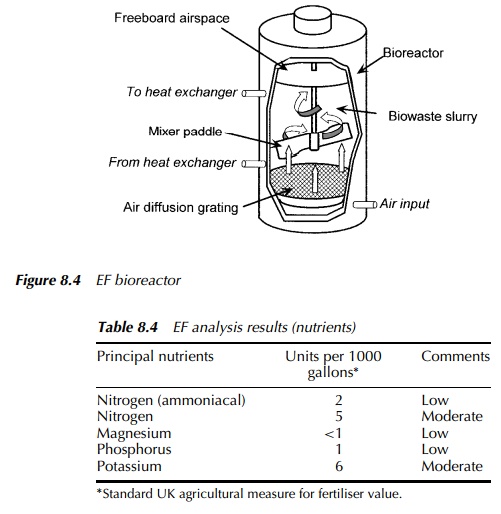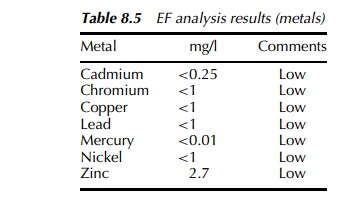Chapter: Environmental Biotechnology: Biotechnology and Waste
Eutrophic fermentation (EF)
Eutrophic fermentation (EF)
Eutrophic fermentation was the name given by one of the authors to
the experi-mental, wet, in-vessel, aerobically enhanced biodegradation process
he designed to investigate accelerated decomposition, principally as an
alternative to anaerobic digestion. Fermentation
in this context relates to the wider application of the word to encompass all
microbial breakdown and not simply the anaerobic pro-duction of alcohol and eutrophic refers to the nutrient-rich
environment within which it takes place.
The process arose as a
result of research into the enhanced aerated remediation of post-anaerobic
digestion liquor. The idea of introducing air into liquid or slurrified waste,
as was discussed is well established as a means of treatment. A laboratory
prototype treatment was developed for the specific effluent and was successfully
trailed at pilot scale, before subsequently being further developed and
extended to the treatment of biowaste.
Eutrophic fermentation
involves rendering the waste into a fine slurry, which is then contained within
a bioreactor (Figure 8.4), aerated by means of bubble diffusers at the base of
the vessel, mixed and heated to around 35 ◦ C. Within this environment, the
input waste breaks down to leave only about 10% of the original volume as
recoverable solids within 35 days. The process liquor itself is characteristically
less strong than for anaerobic digestion and typically contains only some 6 –
10% suspended solids. Analysis of this liquid by the Agricultural Development
Advisory Service (ADAS) has indicated that it has some potential fertiliser
use, based on key performance indicators such as nitrogen, phosphorous and
potassium levels, electrical conductivity, generalised nutrient content and
heavy metal residues. The results are shown in full in Tables 8.4 and 8.5.

With a ‘satisfactory’ pH of
6, a ‘low’ BOD of 2790 mg/l, low ammoniacal nitrogen and the likely slow
release of much of the total nitrogen content over

Though this method proved
itself remarkably efficient in laboratory and inter-mediate trials, the company
for which it was developed subsequently abandoned further research into
biological waste treatment and, consequently, EF has never been taken to pilot
scale. As a result, it is not possible to say how well it might perform, though
for such aerobic processes utilising a completely mixed, suspended growth
regime, even relatively small-scale studies tend to be fair rep-resentations of
full-scale performance. This is particularly relevant to this system, as the
hydrolysed organics are directly assimilated by the resident microbes, rather
than simply accumulating in the process liquor.
In the foreseeable future,
it is unlikely that this approach will make the tran-sition to commercial
application, not least as a result of outstanding intellectual property
questions. Nevertheless, it stands as a worthwhile example of how alter-native
technologies can be developed to meet particular needs.
The issue of local circumstance is a recurrent theme throughout the
whole of environmental biotechnology and probably so in waste management as
much, if not more, than in any other aspect. As a consequence, it is highly
unlikely that any one technology will establish itself as the monopoly
treatment, which effectively also guarantees the scope for the further
development of existing or novel minority biotechnologies.
Related Topics